The Stimson’s python (Antaresia stimsoni), also known as the large-blotched python, is a small, wide-ranging species endemic to Austra
The Stimson’s python (Antaresia stimsoni), also known as the large-blotched python, is a small, wide-ranging species endemic to Australia. Named after Andrew Stimson, a herpetologist at the British Museum, the original description was published in 1985 by Laurie A. Smith of the Western Australia Museum. Smith described two subspecies: the western (A. s. stimsoni) and the eastern (A. s. orientalis) Stimson’s pythons, though the validity of A. s. orientalis has remained controversial. More thorough analysis of the morphological and molecular characteristics is needed to resolve the issue.
Read More
Stimson’s Python Born in Captivity Against the Odds
The Stimson’s is one of the smallest species of python, with an average adult length of about 34 inches. This species is highly polymorphic, and the pattern and coloration varies widely throughout its extensive range. In general, the background color is much lighter than the patterned elements and is typically beige or straw colored. The pattern is well defined and distinct, comprised of irregular blotches colored in various shades, from diamine brown to a dark terra cotta.
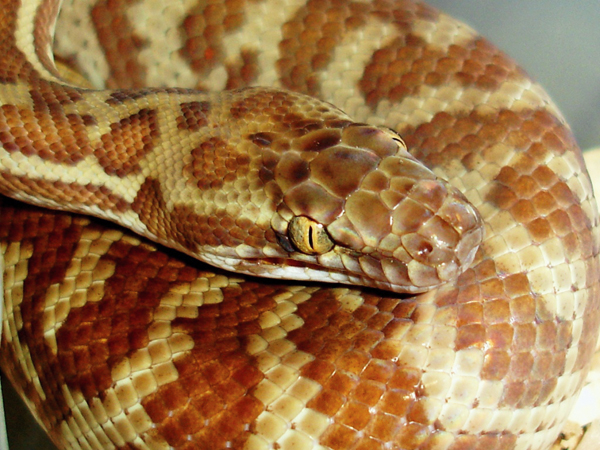
Ryan Young
Antaresia stimsoni inhabits the largest range of any other Autralian python species.
This snake inhabits the largest range of any Australian python and can be found along the west coast from the vicinity of Perth north along the coast to the southern edge of the Kimberley. From there, the python’s range extends east through much of the interior of the continent to the eastern versant of the Great Dividing Range in New South Wales and Queensland. Although the habitat varies widely throughout its range, the Stimson’s python is typically associated with sparsely vegetated rocky areas, dry woodlands and water course gorges.
It was not until the mid to late 1990s that Stimson’s pythons became available to keepers in the United States. Most of the specimens in captivity in the U.S. are the eastern form, and most belong to one lineage. Other lineages are available but not nearly as well established. Captive-bred western Stimson’s pythons are not common in the domestic trade, but there are breeders working to make them more available in the near future. The geographic origins of the captive lineages are not often known, but I keep both the eastern and western forms and they are quite different from one another. No color or pattern morphs are available at this time in the U.S., but there are piebald and caramel-albino morphs in Australian collections.
Housing and Feeding
Maintaining these little pythons is very easy given their typically docile attitude, adaptability and small adult size. The natural environment they come from provides them the ability to handle a wide range of temperatures and makes them extremely hardy in captivity. You can make their housing as simple or complex as you desire, and A. stimsoni is an ideal candidate for a naturalistic style display that imitates their natural environment. On the other hand, I maintain my colony in rack-style housing throughout their entire lives. Adult animals are kept in well-ventilated sweater box-sized tubs measuring 21½ by 15½ by 5 inches). The racks are kept in a dedicated snake room that allows me to maintain an average room temperature of 79 to 81 degrees Fahrenheit. I offer supplemental basking areas using either heat tape or heat rope placed near the rear portion of the tub that I maintain at 85 to 90 degrees, depending on the season and/or the age of the snake.
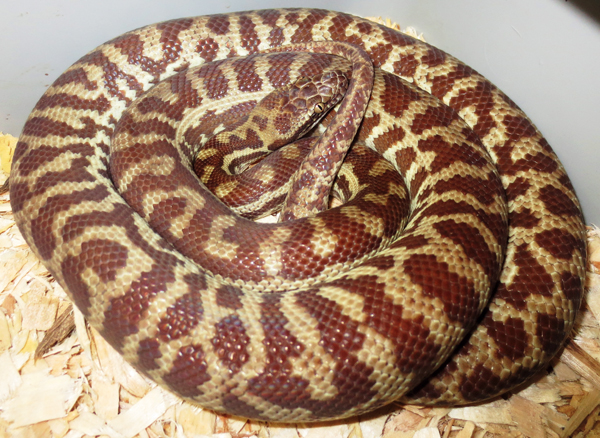
ryan young
For substrate, use aspen wood bedding. It is readily available from a variety of sources.
For substrate, I prefer aspen wood bedding. It is readily available from a variety of sources, including stores that sell pet reptile supplies, and it’s easy to keep clean with regular spot cleaning.
Domestic mice are suitable for a pet Stimson’s python for its entire life. Frozen/thawed mice are generally accepted, and these are usually more convenient for the keeper to provide than live mice. Plus there is less risk of disease with frozen/thawed mice. Pinky mice are easily consumed by baby pythons, and as a snake grows you need only adjust the size of the mouse offered to keep it happy and healthy. An appropriately sized mouse will result in a slightly noticeable bulge at your snake’s thickest point.
Water should be available at all times. I use a disposable, 12-ounce plastic deli cup that is set into a heavy ceramic dish in each tub to prevent the snake from tipping it over. A disposable water cup makes maintenance easier, but any dish that can be easily cleaned and disinfected will work equally well.
Breeding the Stimson’s Python
One of the highlights of keeping any species is to successfully reproduce it in captivity, and breeding the Stimson’s python is an extremely rewarding experience. It is usually a ready breeder, and once you have an adult pair, adjusting the temperatures seasonally is all that is typically required to get them to reproduce.
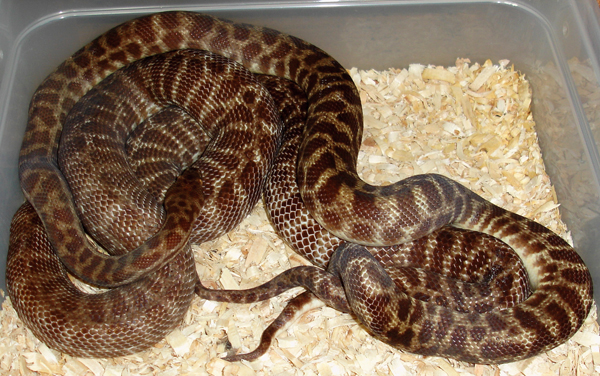
ryan young
As long as you have an adult pair, Stimson’s pythons are usually ready breeders. This is a copulating pair of A. s. orientalis.
An average adult male Stimson’s python in my collection is at least 18 months old and weighs between 120 and 300 grams, but males can mature when very young and small. Females take longer to mature; mine are usually at least 3 years old and 350 to 500 grams before they produce their first clutch of eggs.
I live in the northern part of the U.S. and begin cycling my snakes for breeding on October 1, with the breeding cycle ending on January 1. To cycle them, I gradually lower the night-time temperature from those previously mentioned for several weeks until it gets into the low 70s. The daytime ambient temperature remains at 80 degrees during the cycling period; and I continue to provide a basking spot of 85 to 90 degrees, but only during the day.
I begin placing pairs together a couple weeks into the cycling period, and continue the nighttime lows for several weeks. Then I gradually begin raising the night-time temps back up to the normal range, though I still don’t provide a night-time basking spot at this time. The pythons usually start copulating straight away once the temperatures are raised, and continue to do so for the rest of the season, a period of six to eight weeks.
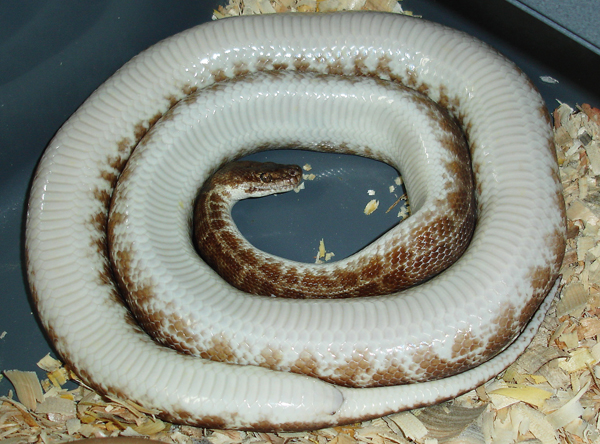
ryan young
During late follicular development and through to egg deposition, females will sit with their bellies inverted.
During late follicular development and through to egg deposition, nearly all female Stimson’s pythons will spend a good deal of time sitting with their bellies inverted. Shortly after the cycle is over, a female will usually begin refusing food—a good sign she will ovulate soon. Ovulation is at its peak for eight to 12 hours, when it looks like the female has eaten a very large prey item, but with the lump positioned slightly further back down the body than where a food bulge would be located. The exact time of ovulation can be easily missed if you do not watch the female closely.
Within a few days of ovulating, the female will experience a pre-lay shed, and 21 to 30 days after that, you can expect eggs to be laid. Female Stimson’s pythons are usually very diligent mothers and take great care of their clutches.
An average clutch in my collection ranges from eight to 12 eggs. I remove them from the female upon discovery and set them up in tall, 6-inch, 64-ounce deli cups half filled with slightly moistened vermiculite. Most of the time I leave the egg mass positioned as it was laid. Some breeders allow maternal incubation by the female and have had great results, but I prefer to use an incubator.
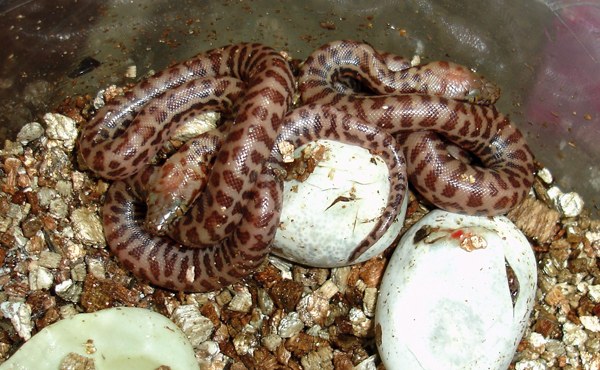
ryan young
Eggs usually hatch after 45 to 49 days of incubation.
I incubate A. stimsoni eggs at 87.5 to 88.5 degrees, and they usually begin to hatch after 45 to 49 days of incubation, which is quite fast compared to other python species. The babies usually emerge from the eggs within 24 hours of pipping.
Baby Husbandry
After baby Stimson’s pythons emerge from their eggs, I rinse off any vermiculite that has stuck to them before placing each one into its own small tub (11 by 6½ by 4 inches) within a baby rack system. The rack must be very secure because baby A. stimsoni are extremely small at around 8 grams at hatching. On more than one occasion I have witnessed cannibalism among the babies of this species, so I highly recommend keeping them in separate tubs right from the start.
I use paper towel substrate until the babies are feeding well. They usually undergo their first shed nine to 14 days after they hatch, and until they have shed I keep a portion of the paper towel slightly damp to ensure a good shed. Neonates absorb a good portion of yolk from their eggs, which provides them the nutrition they need to get a start on life. I don’t start feeding trials until a couple weeks after their first shed.
The most challenging aspect of breeding Stimson’s pythons is getting the babies established and feeding on domestic mice. Wild baby Stimson’s pythons feed almost exclusively on small lizards, but this often is not feasible in captivity, so I use pinky mice. Fortunately, the majority of baby Stimson’s pythons are easily provoked into striking, so tease-feeding has proven the best way to get them eating.
To tease-feed a baby, hold a dead pinky in some tongs and begin gently prodding and pushing it at the snake in an attempt to irritate it into biting onto the food. Once it does, release the pinky and hope the baby python wraps around it to constrict and eat it. It may take several attempts and some patience on your part for this to occur, but each time it should take less effort before the snake accepts the pinky.
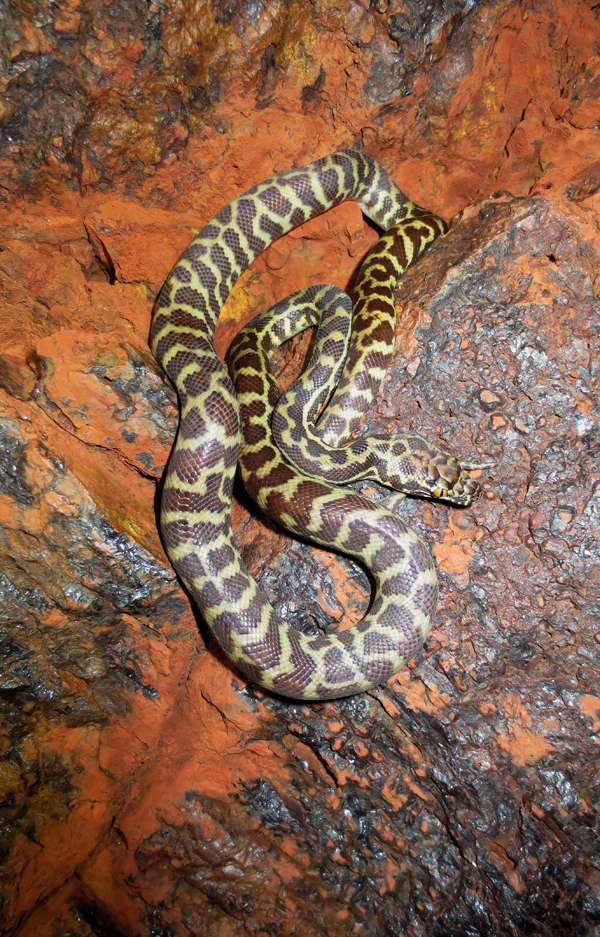
ryan young
This is a wild Stimson’s python the author found in Australia.
After a few tease-feedings, young A. stimsoni will usually remain problem-free feeders. However, it may be necessary to force-feed stubborn individuals that refuse all attempts. This entails placing a prey item directly into the snake’s mouth and hoping it starts to swallow the item on its own, or using some sort of instrument, such as a blunt probe, to help push it gently down the snake’s throat. If the snake shows any signs of aggression during force feeding, go back to tease feeding.
Baby Stimson’s pythons are typically quite defensive at first, but once they are established you can start working with them and they will usually become accustomed to being handled. Nearly all the adults I have raised have turned out to be great, amiable captives. Most have a strong feeding response and quickly learn to associate the keeper with food, so I recommend using a snake hook to begin interactions with them so your warm hand reaching into the enclosure is not mistaken for a warm mouse. Once they realize you’re not offering food, they quickly calm down and are easily handled.
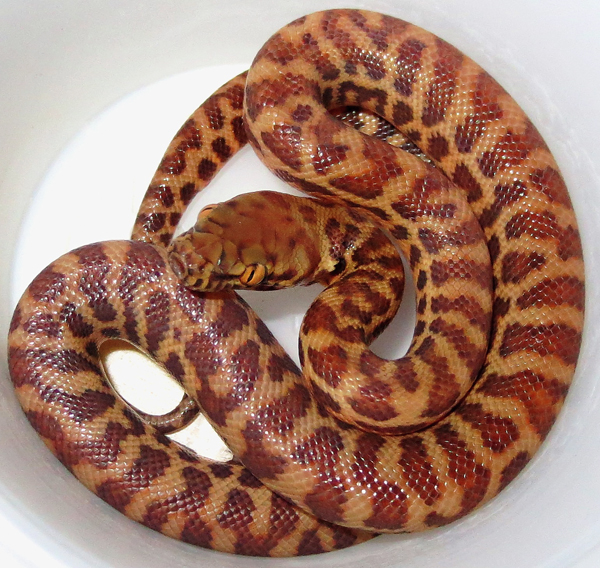
ryan young
Baby Stimson’s pythons are typically quite defensive at first, but once they are established you can start working with them and they will usually become accustomed to being handled.
Any snake keeper, from the novice to the advanced, will enjoy working with this amazing little python. The amount of natural variation and selective breeding potential promises a bright future for anyone willing to make a place for them in their collections. Stimson’s pythons have been a part of my collection for the past 14 years. In that time I have worked with most of the other available species of python, and I can truly say A. stimsoni is one of my favorite species. If you are looking for an interesting and rewarding experience with an extremely manageable python, the Stimson’s python could be just what you are looking for.
Other Antaresia
Currently, the genus Antaresia includes four species. In addition to A. stimsoni, there is the pygmy or anthill python (A. perthensis), the Children’s python (A. childreni) and the spotted python (A. maculosa). The genus was long considered to be endemic to Australia, but in 2000, Mark O’Shea and Robert Sprackland collected a small python closely resembling a spotted python in the Fly River delta of Western Province, Papua-New Guinea. Since then, several more specimens have been reported from a nearby locality that is in Papua, Indonesia. More extensive research will need to be done to determine the relationship of the New Guinea population to the Australian Antaresia.
All Stimson’s pythons available in the domestic trade are captive bred, so internal parasites are rarely a concern. External parasites such as snake mites are always a possibility when bringing a new reptile into an established collection, however, so I highly recommend quarantining any new reptile away from the rest of your collection for a minimum of 90 days. This will give you a chance to determine the health of the new animal.
With proper care, a Stimson’s python could live quite a long time. I have a couple specimens in my collection that are at least 25 years old, and I suspect they could live for many more years.
Ryan Young is a professional reptile breeder with one of the most diverse python collections in the U.S. He owns and operates Molecular Reptile, and his primary interest is in maintaining unique and pure forms of the Australian and Indonesian species, as well as producing amazing mutations of several species. Visit his website at molecularreptile.com.


